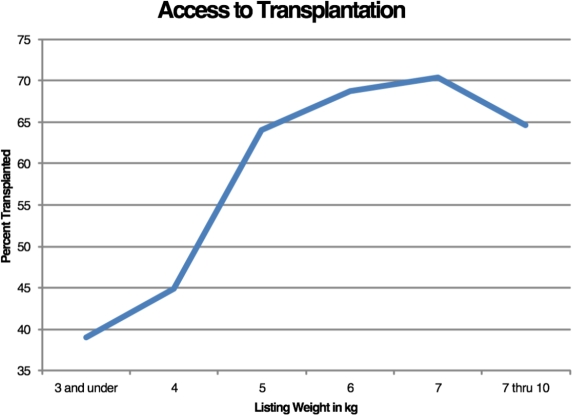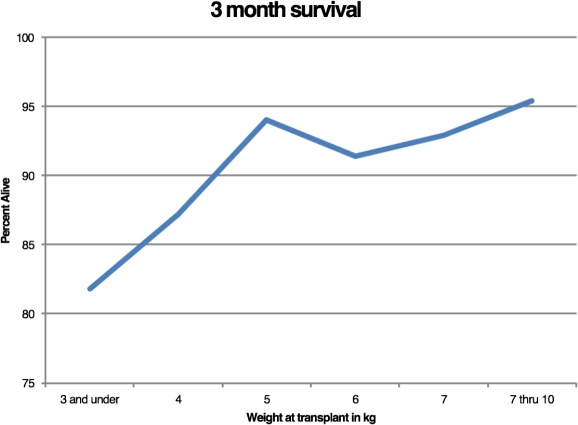How Small Is Too Small: A Comparison of Access and Survival by Weight in Pediatric Liver Transplant Recipients.
Division of Abdominal Transplantation, Baylor College of Medicine, Houston, TX.
Meeting: 2016 American Transplant Congress
Abstract number: D202
Keywords: Liver transplantation, Pediatric, Survival, Weight
Session Information
Session Name: Poster Session D: Pediatric Liver Transplantation
Session Type: Poster Session
Date: Tuesday, June 14, 2016
Session Time: 6:00pm-7:00pm
 Presentation Time: 6:00pm-7:00pm
Presentation Time: 6:00pm-7:00pm
Location: Halls C&D
Introduction: Orthotopic liver transplantation is a well-established treatment modality for a wide variety of pediatric illness. With its associated technical challenges, paucity of size-matched allografts, and difficult peri- and post-operative management, transplantation in the very small-sized recipient is especially trying. There is currently a dearth of literature examining outcomes in this population.
Purpose: The purpose of this study is to examine access to transplantation as well as compare postoperative survival in small (weight <10 kg) OLT recipients.
Methods: We analyzed all pediatric (<18 years) candidates for liver transplantation in the OPTN database from 2002 to 2013, excluding combined heart-liver (n=14), lung-liver (n=14), and intestine-liver transplants (n=879). For the access analysis, we followed all candidates listed for liver transplant (n=8380) until transplantation. For the survival analysis, we followed all transplanted recipients (n=5489) until death or last known follow up. We used Kaplan-Meier functions for our time-to-event analysis and performed threshold analysis in 1 kg increments.
Results: The transplant rate was 65.5% over the study period. Using threshold analysis we find a significant reduction in the transplant rate from 5 to 4 kg.  3-month survival was 94.6%, 6-month survival was 93.4%, 9-month survival was 92.8%, and 1-year survival was 92.1%. Threshold analysis revealed a significant reduction from 5 to 4 kg.
3-month survival was 94.6%, 6-month survival was 93.4%, 9-month survival was 92.8%, and 1-year survival was 92.1%. Threshold analysis revealed a significant reduction from 5 to 4 kg.  Our survival analysis was unadjusted. 5.9% of recipients were under 5 kg.
Our survival analysis was unadjusted. 5.9% of recipients were under 5 kg.
Conclusion: Our data suggests patients less than 5 kg have a significantly decreased probability of liver transplantation as well as lower survival in comparison to their larger counterparts. This should be a consideration in both preoperative nutritional optimization as well as recipient selection for OLT.
CITATION INFORMATION: Steen E, Cotton R, Rana A. How Small Is Too Small: A Comparison of Access and Survival by Weight in Pediatric Liver Transplant Recipients. Am J Transplant. 2016;16 (suppl 3).
To cite this abstract in AMA style:
Steen E, Cotton R, Rana A. How Small Is Too Small: A Comparison of Access and Survival by Weight in Pediatric Liver Transplant Recipients. [abstract]. Am J Transplant. 2016; 16 (suppl 3). https://atcmeetingabstracts.com/abstract/how-small-is-too-small-a-comparison-of-access-and-survival-by-weight-in-pediatric-liver-transplant-recipients/. Accessed December 27, 2025.« Back to 2016 American Transplant Congress
